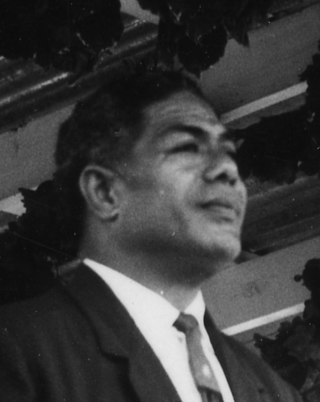Top Qs
Timeline
Chat
Perspective
Malietoa Tanumafili II
O le Ao o le Malo of Samoa from 1962 to 2007 From Wikipedia, the free encyclopedia
Remove ads
Malietoa Tanumafili II GCMG CBE (4 January 1913 – 11 May 2007) was a Samoan paramount chief and politician who was O le Ao o le Malo (head of state) of Samoa from its independence in 1962, and the holder of the Malietoa title from 1940, until his death in 2007.
After becoming the Malietoa, he worked as a civil servant and parliamentarian. When the state of Western Samoa was founded in 1962, gaining independence from New Zealand, he became joint head of state with Tupua Tamasese Meaʻole, who died on 15 April 1963, after which he remained the office's sole occupant until his own death.[1]
Remove ads
Early life
Tanumafili was born on 4 January 1913[a] as the son and third child of his parents, Malietoa Tanumafili I and Momoe Lupeuluiva Meleisea.[4]
He inherited the royal title of Malietoa in 1940, following the 1939 death of his father, Malietoa Tanumafili I,[5] though some media reports claim that he received the title of Malietoa in 1939. The Malietoa is one of the four tamaʻāiga (maximal lineage) titles, alongside the Tupua Tamasese, Mataʻafa and Tuimalealiʻifano.[6]
He was educated at the government-run Leififi School in Samoa. He went on to enroll at St. Stephen's School and Wesley College in Pukekohe, both of which are in New Zealand.[7]
Remove ads
Early public career
Soon after becoming Malietoa, he was appointed a special adviser (fautua) to the New Zealand administration over Samoa.[5][8] During his earlier career, he worked for several years alongside Tupua Tamasese Meaʻole, serving in multiple conventions related to constitutional reform as part of the transition to independence. Both were also members of the Legislative Assembly before their resignation in 1957.[9] In 1959, Malietoa was appointed joint chairman of a working committee which advised New Zealand lawyers on drafting the Samoan constitution.[2]
Remove ads
O le Ao o le Malo (1962–2007)
Upon Samoa's independence in 1962, Malietoa and Tupua Tamasese became O Ao o le Malo, the heads of state of Samoa jointly appointed under the constitution for a lifetime term. When Tupua Tamasese died sixteen months later in April 1963, Malietoa became the sole head of state.[10]
Malietoa travelled extensively as O le Ao o le Malo. He conducted a state visit to the People's Republic of China in September 1976.[11] He also visited Australia, Fiji, Tonga, Nauru, Hawaii, Japan, New Zealand, South Korea, the United Kingdom, and West Germany. He was among the foreign dignitaries who attended the 1984 Summer Olympics in Los Angeles and the funeral of Japanese Emperor Shōwa in 1989.[7][12]
In 1999, amid the fallout from the murder of a reformist politician and cabinet minister, Luagalau Levaula Kamu, Malietoa commuted the death sentences which were handed out to the two perpetrators to life imprisonment, and reportedly also visited them in prison.[2] On 9 August 2004, he bestowed the chiefly Seiuli title upon professional wrestler and actor Dwayne Johnson, when the latter visited Samoa with his mother Ata Maivia.[13][14]
Death
Malietoa died at the age of 94 on 11 May 2007 after being treated for pneumonia, and was buried on 18 May.[15][16] His death triggered the first election for an O le Ao o le Malo in Samoa's post-independence history as required by the constitution.[17]
Honours and legacy
Malietoa was appointed a Commander of the Order of the British Empire in 1959.[2] In 1977, Elizabeth II visited Samoa for a single day as part of her tour of the South Pacific on board the Royal Yacht Britannia. While in Samoa, she presented Malietoa with the Collar Badge and Star of a Knight Grand Cross of the Order of St Michael and St George.[18]
Malietoa is often credited for providing much of the stability that Samoa has enjoyed post independence.[10]
Remove ads
Personal life
Malietoa was an active athlete during his younger years. His favourite sports included boxing, rugby and cricket.[7] Malietoa's interest in sports continued throughout his life and he was an avid golfer well into his nineties. He could often be seen driving his golf cart around Samoa.[2][10]
In 1973, he converted to the Baháʼí Faith. He was the first serving head of state to be a member of the religion.[19][20] In 1976, he visited the graveside of Shoghi Effendi, first and last Guardian of the Baháʼí Administrative Order, in London.[21] In 1979 he laid the foundational cornerstone of the Baháʼí House of Worship in Tiapapata, eight kilometres from the capital of Apia.[22] The temple was subsequently dedicated by him at completion in 1984.[23] Despite now adhering to the Baháʼí Faith, Malietoa continued to acknowledge the Christian tradition within his family dating back to 1830.[2]
His wife, Lili Tunu, whom he married in 1940, died in 1986.[24][25] The couple had eleven children, including Papaliʻi Laupepa, Papaliʻi Faʻamausili Molī (later Malietoa Moli II) and Papaliʻi Momoe Von Reiche, of which two sons and two daughters survived Malietoa when he died.[12][26][27]
Remove ads
Family tree
| ||||||||||||||||||||||||||||||||||||||||||||||||||||||||||||||||||||||||||||||||||||||||||||||||||||||||||||||||||||||||||||||||||||||||||||||||||||||||||||||||||||||||||||||||||||||||||||||||||||||||||||||||||||||||||||||||||||||||||||||||||||||||||||||||||||||||||||||||||
Notes:
| ||||||||||||||||||||||||||||||||||||||||||||||||||||||||||||||||||||||||||||||||||||||||||||||||||||||||||||||||||||||||||||||||||||||||||||||||||||||||||||||||||||||||||||||||||||||||||||||||||||||||||||||||||||||||||||||||||||||||||||||||||||||||||||||||||||||||||||||||||
Remove ads
Notes
References
External links
Wikiwand - on
Seamless Wikipedia browsing. On steroids.
Remove ads

